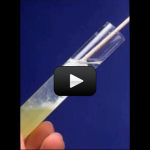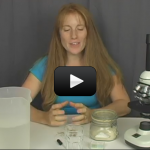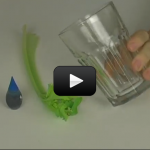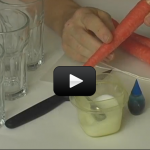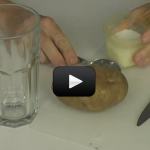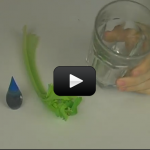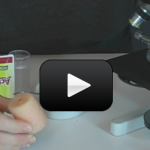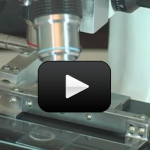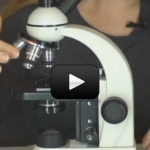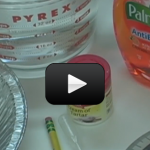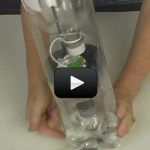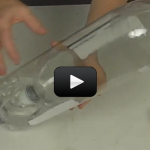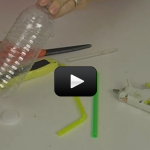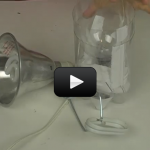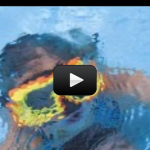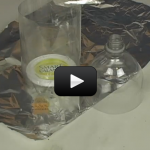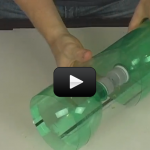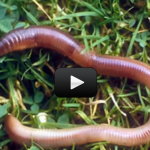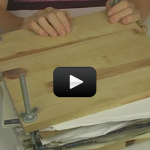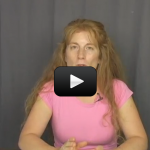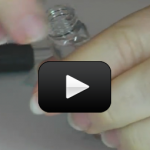Extracting DNA in your Kitchen
If the cell has a nucleus, the DNA is located in the nucleus. If not, it is found in the cytoplasm. DNA is the genetic material that has all the information about a cell. DNA is a long molecule found in the formed by of two strands of genes. DNA carries two copies—two “alleles”—of each … Continue reading "Extracting DNA in your Kitchen" |
Protozoa in the Grass
This experiment allows you to see protozoa, tiny-single celled organisms, in your compound microscope. While I can go in my backyard and find a lot of interesting pond scum and dead insects, I realize that not everybody has a thriving ecosystem on hand, especially if you live in a city. I am going to show … Continue reading "Protozoa in the Grass" |
Membranes
Here’s a fun experiment that shows you how much stuff can pass through a membrane. Scientist call it the semi-permeability of membranes. Before we start, take out your science journal and answer this question: What do you think will happen when we stick a piece of celery into a glass of regular water. Anything special? … Continue reading "Membranes" |
Cool Carrot Osmosis
The carrot itself is a type of root—it is responsible for conducting water from the soil to the plant. The carrot is made of cells. Cells are mostly water, but they are filled with other substances too (organelles, the nucleus, etc). We’re going to do two experiments on a carrot: first we’re going to figure … Continue reading "Cool Carrot Osmosis" |
Osmosis in Potatoes & Beans
One way substances can get into a cell is called passive transport. One special kind of passive transport is osmosis, when water crosses into the cell. This experiment allows you to see the process of osmosis in action. Are you ready? |
Celery Stalk Water Race
If you think of celery as being a bundle of thin straws, then it’s easy to see how this experiment works. In this activity, you will get water to creep up through the plant tissue (the celery stalk) and find out how to make it go faster and slower. The part of the celery we … Continue reading "Celery Stalk Water Race" |
Slide Preparation: Heat Fixes
Make sure you've completed the How to Use a Microscope and also the Wet Mount and Staining activities before you start here!If you tried looking at animal cells already, you know that they wiggle and squirm all over the place. And if you tried looking when using the staining technique, you know it only makes … Continue reading "Slide Preparation: Heat Fixes" |
Slide Preparation: Staining
Make sure you’ve completed the How to Use a Microscope and also the Wet Mount activities before you start here! If your critter is hard to see, you can use a dye to bring out the cell structure and make it easier to view. There are lots of different types of stains, depending on what … Continue reading "Slide Preparation: Staining" |
How to Use a Microscope: Optics, Observing, and Drawing Techniques
How do the lenses work to make objects larger? We’re going to take a closer look at optics, magnification, lenses, and how to draw what you see with this lesson. Here’s a video to get you started: Here’s what you do: |
Measuring the Size of a Molecule
Molecules are the building blocks of matter. You’ve probably heard that before, right? But that does it mean? What does a molecule look like? How big are they? While you technically can measure the size of a molecule, despite the fact it’s usually too small to do even with a regular microscope, what you can’t … Continue reading "Measuring the Size of a Molecule" |
Water Cycle Column: Is Rain Pure?
When birds and animals drink from lakes, rivers, and ponds, how pure it is? Are they really getting the water they need, or are they getting something else with the water? This is a great experiment to see how water moves through natural systems. We’ll explore how water and the atmosphere are both polluted and … Continue reading "Water Cycle Column: Is Rain Pure?" |
Terraqua Column
How does salt affect plant growth, like when we use salt to de-ice snowy winter roads? How does adding fertilizer to the soil help or hurt the plants? What type of soil best purifies the water? All these questions and more can be answered by building a terrarium-aquarium system to discover how these systems are … Continue reading "Terraqua Column" |
Make an Insect Aspirator
Some insects are just too small! Even if we try to carefully pick them up with forceps, they either escape or are crushed. What to do? Answer: Make an insect aspirator! An insect aspirator is a simple tool scientists use to collect bugs and insects that are too small to be picked up manually. Basically … Continue reading "Make an Insect Aspirator" |
Berlese funnel
Unsurprisingly, often the most interesting critters found in soil are the hardest to find! They’re small, fast, and used to avoiding things that search for them. So, how do we find and study these tiny insects? With a Berlese Funnel (Also called the Tullgren funnel)! |
Make a Waterscope
As you walk around your neighborhood, you probably see many other people, as well as some birds flying around, maybe some fish swimming down a local stream, and perhaps even a lizard darting behind a bush or a frog sitting contently on top of a pond. Most likely, you know that all of these living … Continue reading "Make a Waterscope" |
Predator-Prey: Who Eats Whom?
The way animals and plants behave is so complicated because it not only depends on climate, water availability, competition for resources, nutrients available, and disease presence but also having the patience and ability to study them close-up. We’re going to build an eco-system where you’ll farm prey stock for the predators so you’ll be able … Continue reading "Predator-Prey: Who Eats Whom?" |
Eco-Column
What grows in the corner of your windowsill? In the cracks in the sidewalk? Under the front steps? In the gutter at the bottom of the driveway? Specifically, how doe these animals build their homes and how much space do they need? What do they eat? Where do fish get their food? How do ants … Continue reading "Eco-Column" |
Worms!
Here we’re going to discuss the differences between three types of worms; flatworms, roundworms, and segmented worms. The word “worm” is not, in fact, a scientific name. It’s an informal way of classifying animals with long bodies and no appendages (no including snakes). They are bilaterally symmetrical (the right and left sides mirror each other). … Continue reading "Worms!" |
Plant Press
Art and science meet in a plant press. Whether you want to include the interesting flora you find in your scientific journal, or make a beautiful handmade greeting card, a plant press is invaluable. They are very cheap and easy to make, too! |
Einstein’s Garden
Mass and energy are conserved. This means you can’t create or destroy them, but you can change their location or form. Most people don’t understand that the E energy term means all the energy transformations, not just the nuclear energy. The energy could be burning gasoline, fusion reactions (like in the sun), metabolizing your lunch, … Continue reading "Einstein’s Garden" |
Protozoa in the Grass
This experiment allows you to see protozoa, tiny-single celled organisms, in your compound microscope. While I can go in my backyard and find a lot of interesting pond scum and dead insects, I realize that not everybody has a thriving ecosystem on hand, especially if you live in a city. I am going to show … Continue reading "Protozoa in the Grass" |
Celery Stalk Water Race
If you think of celery as being a bundle of thin straws, then it’s easy to see how this experiment works. In this activity, you will get water to creep up through the plant tissue (the celery stalk) and find out how to make it go faster and slower. The part of the celery we … Continue reading "Celery Stalk Water Race" |
Osmosis in Potatoes & Beans
One way substances can get into a cell is called passive transport. One special kind of passive transport is osmosis, when water crosses into the cell. This experiment allows you to see the process of osmosis in action. Are you ready? |
Cool Carrot Osmosis
The carrot itself is a type of root—it is responsible for conducting water from the soil to the plant. The carrot is made of cells. Cells are mostly water, but they are filled with other substances too (organelles, the nucleus, etc). We’re going to do two experiments on a carrot: first we’re going to figure … Continue reading "Cool Carrot Osmosis" |
Membranes
Here’s a fun experiment that shows you how much stuff can pass through a membrane. Scientist call it the semi-permeability of membranes. Before we start, take out your science journal and answer this question: What do you think will happen when we stick a piece of celery into a glass of regular water. Anything special? … Continue reading "Membranes" |
How to Use a Microscope: Optics, Observing, and Drawing Techniques
How do the lenses work to make objects larger? We’re going to take a closer look at optics, magnification, lenses, and how to draw what you see with this lesson. Here’s a video to get you started: Here’s what you do: |
Preparing a Wet Mount Slide
Make sure you’ve completed the How to Use a Microscope activity before you start here! Anytime you have a specimen that needs water to live, you’ll need to prepare a wet mount slide. This is especially useful for looking at pond water (or scum), plants, protists (single-cell animals), mold, etc. When you keep your specimen … Continue reading "Preparing a Wet Mount Slide" |
Slide Preparation: Staining
Make sure you’ve completed the How to Use a Microscope and also the Wet Mount activities before you start here! If your critter is hard to see, you can use a dye to bring out the cell structure and make it easier to view. There are lots of different types of stains, depending on what … Continue reading "Slide Preparation: Staining" |
Slide Preparation: Heat Fixes
Make sure you’ve completed the How to Use a Microscope and also the Wet Mount and Staining activities before you start here! If you tried looking at animal cells already, you know that they wiggle and squirm all over the place. And if you tried looking when using the staining technique, you know it only … Continue reading "Slide Preparation: Heat Fixes" |

